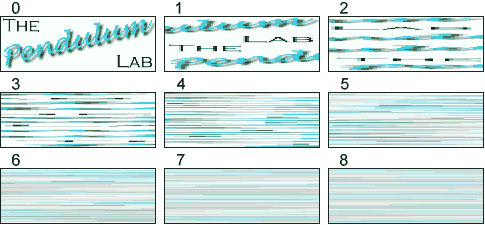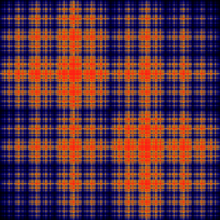Baker's map
The baker's transformation (English baker 's map ) is named after the process of Teigknetens: A dough is pulled to twice the length and then folded. This procedure is repeated until a good mixing is obtained. Two hypothetical particles in the dough ( point- adopted "raisin " ) that were originally close together, are far apart after repeated application of this transformation.
With the baker transformation can be illustrated in a simple way how chaotic behavior arises from the interplay of lines and wrinkles.
Formal Description
In the literature there are different formulas for the Baker transformation. The formulas differ by itself
- The type of folding and
- The consideration of the dough as infinitely thin or of finite thickness.
Infinitely thin dough
For simplicity we consider a one-dimensional dough ( since the dough is stretched in one direction, the second direction parallel to the table surface plays no role ). Formally, we can represent this piece of dough through the unit interval. The baker's transformation is then a mapping of the unit interval into itself, ie.
The simplest form of the baker transformation occurs when you roll out the dough to double the length and then folded so that the two ends come to lie on each other. Mathematically describe this transformation by
An alternative form of the baker transformation is obtained if one cuts the rolled dough in the center and superimposing the two halves without rotating them against each other. For this is the mathematical description
Dough of finite thickness
If we consider a dough of finite thickness, we need to introduce a second variable that describes the vertical distance of our hypothetical particle of the tabletop. In the literature, most are the variables and used; Here, the height is to be represented by the variable, in order to enable a more intuitive understanding of the formulas.
For simplicity, one considers a dough of height 1, so that the baker transformation is now a mapping of the unit square into itself, ie. In the Figure is the same as above; the picture in results from the consideration that the thickness of the dough is cut in half when coasting to double the length and from the respective convolution operation.
When the dough is folded after being rolled out, is the mathematical description
The dough is, however, cut and superimposed, the result is
Swell
- Erich W. Weisstein: Baker 's Map. From MathWorld - A Wolfram Web Resource (see here)
- Roman Worg: Deterministic chaos. Ways in which non-linear dynamics. BI Publisher Science, Mannheim, Germany 1993, ISBN 3-411-16251-1.
- Nonlinear Dynamics
- Transformation










